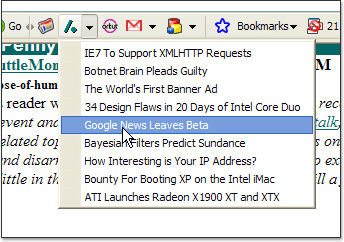At that time, Google suggested to "get the Google Toolbar for your IE browser and take the power of Google with you anywhere on the web." Internet Explorer was the dominant browser and it didn't have a search box, so Google Toolbar was a great way to promote Google. It also made it easier to search the web.

Since then, Google Toolbar added many new features: pop-up blocker, online bookmarks, custom buttons, inline find-in-page, automatic translation, spell checking, suggestions on navigation errors and more. Some of these features were integrated in Internet Explorer. Google made a lot of business deals and many popular applications bundled Google Toolbar. Google also developed a version of the Toolbar for Firefox, but it was discontinued in 2011.
For many years, Google Toolbar was the most important Google software. Internet Explorer was the only popular browser that didn't use Google as the default search engine. "Microsoft's Internet Explorer web browser, now accounts for less than 60% of the market, down from 95% at its peak in 2003," mentioned a BBC News article from 2010.
Internet Explorer's market share has decreased as Firefox and Google Chrome became more popular. Even though Microsoft started to update the software more often and Internet Explorer became faster and added support for many HTML5 features, the 5-year stagnation between IE6 (2001) and IE7 (2006), the 2-year gap between IE7 and IE8, IE9's lack of support for Windows XP, as well as the increased popularity of web apps like Gmail or Google Docs - all of these made Internet Explorer a distant memory for many users.
Google Chrome is now the most popular browser, according to Google. This means that Internet Explorer is no longer the dominant browser from the early 2000s. Google now focuses on promoting Chrome, which is a lot more important for Google: Chrome users are more likely to use Google's services and Google can improve the overall browsing experience, instead of only adding a few features.
Just like Google discontinued Chrome Frame, you can expect to see a similar announcement for Google Toolbar. Google Bookmarks will also disappear if Google Toolbar is discontinued, since Toolbar is the only product that uses it.

The last major Google Toolbar release was in 2011, so the Toolbar is probably in maintenance mode. If you visit the Toolbar site in Chrome, you'll see this message: "You're using Chrome, that's great. All of the features of Google Toolbar are already built into your browser." That's not quite true, but Google probably thinks that the missing features aren't very important or can be replaced by Chrome extensions.
Toolbars are no longer fashionable, they take up a lot of space and slow down browsers. Today's browsers have minimalist interface and use most of the space to display web pages. More reasons to discontinue Google Toolbar.

























